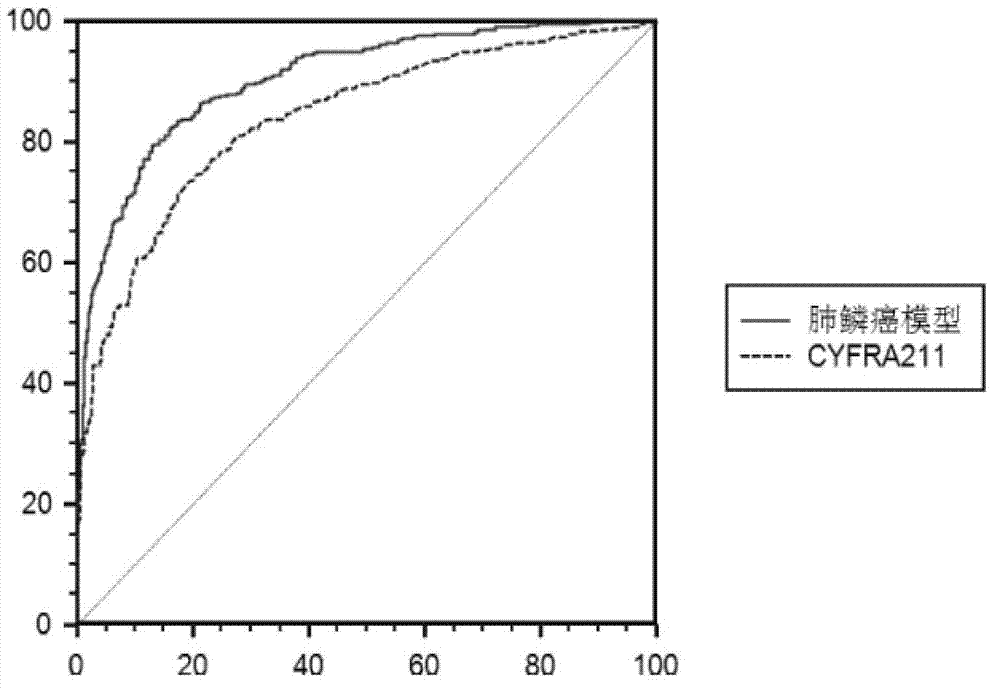Kit for auxiliary diagnosis of squamous cell lung carcinoma patient
A technology for auxiliary diagnosis and squamous cell carcinoma of the lung, applied in biological testing, material inspection products, measuring devices, etc., can solve problems such as low diagnostic efficiency and failure to meet clinical needs, and achieve high sensitivity and strong specificity
- Summary
- Abstract
- Description
- Claims
- Application Information
AI Technical Summary
Problems solved by technology
Method used
Image
Examples
Embodiment 1
[0032] Embodiment 1, establishment of the inventive method
[0033] 1. Model establishment
[0034]A total of 489 plasma samples from patients with squamous cell carcinoma of the lung and 479 plasma samples from healthy people (normal controls) were collected from lung cancer patients diagnosed by pathology in the Department of Thoracic Surgery, Cancer Hospital, Chinese Academy of Medical Sciences, and normal people who participated in cancer screening. This experiment was approved by the Ethics Committee, and all subjects were informed and signed an informed consent form. Among patients with squamous cell carcinoma of the lung, there were 466 males and 23 females, with an age range of 28-86 years, with an average age of 61.56 years; among the normal population, there were 240 males and 239 females, with an age range of 41-70 years, with an average age of 61.56 years. For 57.39 years. Plasma samples were obtained before surgery, and the patients had not received chemotherapy...
Embodiment 2
[0045] Embodiment 2, verification of the inventive method
[0046] The patients used in this example were 150 patients with clinically diagnosed squamous cell carcinoma of the lung (peripheral venous blood was obtained before surgery, and the patients had not received chemotherapy, radiotherapy, intervention, etc.) and 50 healthy people (non-squamous cell carcinoma of the lung) patients), all volunteers who gave informed consent.
[0047] 1. Take 5ml of peripheral venous blood from the patient to be tested on an empty stomach, let it stand at room temperature for 1h, then centrifuge at 3000r / min for 15min, take the supernatant, divide it into two 1.5mL EP tubes, and store in a -80°C refrigerator.
[0048] 2. Dissolve the sample from step 1 at room temperature for 3 hours, then centrifuge at 3000r / min for 5 minutes.
[0049] 3. Detect the concentration of the protein marker IDH1 (in U / L), the concentration of the protein marker CA125 (in U / mL), and the concentration of the pro...
PUM
| Property | Measurement | Unit |
|---|---|---|
| Sensitivity | aaaaa | aaaaa |
Abstract
Description
Claims
Application Information
 Login to View More
Login to View More - R&D
- Intellectual Property
- Life Sciences
- Materials
- Tech Scout
- Unparalleled Data Quality
- Higher Quality Content
- 60% Fewer Hallucinations
Browse by: Latest US Patents, China's latest patents, Technical Efficacy Thesaurus, Application Domain, Technology Topic, Popular Technical Reports.
© 2025 PatSnap. All rights reserved.Legal|Privacy policy|Modern Slavery Act Transparency Statement|Sitemap|About US| Contact US: help@patsnap.com



